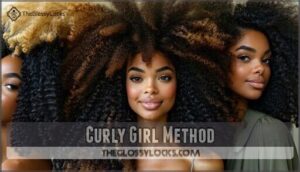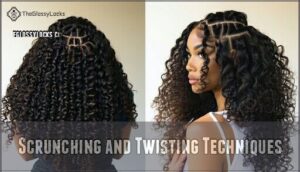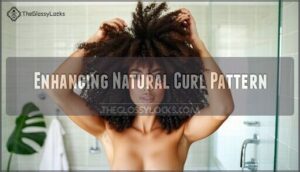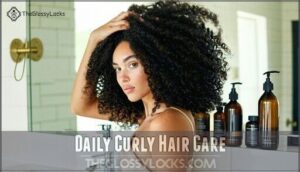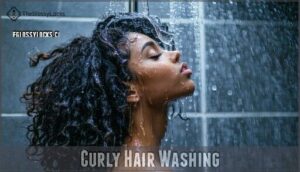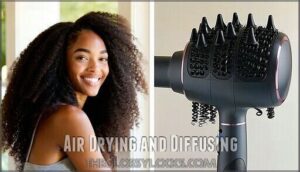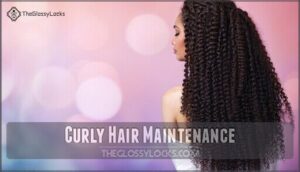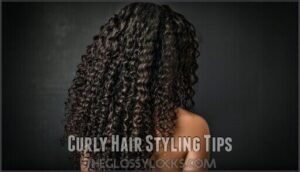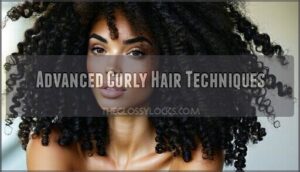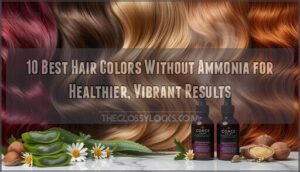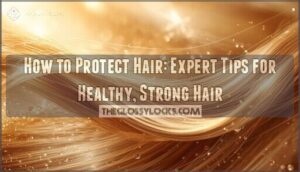This site is supported by our readers. We may earn a commission, at no cost to you, if you purchase through links.
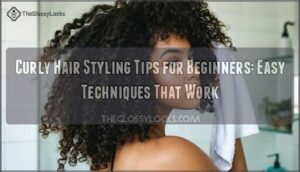 Starting your curly hair journey doesn’t have to feel overwhelming. The key curly hair styling tips for beginners focus on embracing your natural texture rather than fighting it.
Starting your curly hair journey doesn’t have to feel overwhelming. The key curly hair styling tips for beginners focus on embracing your natural texture rather than fighting it.
You’ll want to ditch traditional shampoos that strip moisture and switch to gentle cleansers or co-washing methods. Apply leave-in conditioner to damp hair, scrunch gently to encourage curl formation, and avoid touching your curls while they dry.
Use a microfiber towel or cotton t-shirt instead of regular towels to reduce frizz. The right techniques can transform unruly curls into defined, bouncy spirals that’ll have you wondering why you ever reached for that flat iron.
Table Of Contents
- Key Takeaways
- Curly Hair Basics
- Curly Girl Method
- Curly Hair Styling
- Daily Curly Hair Care
- Curly Hair Washing
- Curly Hair Drying
- Curly Hair Maintenance
- Curly Hair Styling Tips
- Advanced Curly Hair Techniques
- Frequently Asked Questions (FAQs)
- How do beginners manage curly hair?
- What is the 1/2/3 gel method for curly hair?
- How do I style my naturally curly hair?
- Do and don’ts for curly hair?
- How to build a curly hair routine?
- How do you curl a hairstyle?
- How do you make curly hair look more Curly?
- How can I make my curly hair easier to style?
- How to bring out your natural curls?
- What comes first in a curly hair routine?
- Conclusion
Key Takeaways
- **You’ll need to switch from traditional harsh shampoos to sulfate-free cleansers or co-washing methods to protect your curls’ natural moisture and prevent stripping essential oils.
- **Apply leave-in conditioner to damp hair and scrunch gently upward to encourage curl formation, then avoid touching your curls while they dry to prevent frizz and breakage.
- **Use microfiber towels or cotton t-shirts instead of regular bath towels when drying to reduce friction and frizz that can damage your curl pattern.
- **Work with your natural curl texture rather than fighting it by understanding your specific curl pattern (2A-4C) and choosing products that match your hair’s porosity and thickness levels.
Curly Hair Basics
Before you can style your curls effectively, you need to understand your hair’s unique characteristics.
Your curl pattern, texture, and porosity determine which products and techniques will work best for your specific hair type.
Understanding Curl Patterns
Understanding your curly hair type marks the beginning of your styling journey.
A curl type chart helps identify whether you have wavy, curly, or coily patterns ranging from 2A to 4C.
Each curl pattern requires different approaches for product selection and styling techniques, and natural curls vary in tightness, volume, and behavior based on your specific hair texture and environmental factors like humidity.
Hair Texture and Porosity
Beyond curl patterns, your hair’s texture and porosity levels determine how products work with your curls. Hair texture refers to strand thickness, while porosity measures how well your hair absorbs moisture and products.
- Fine texture absorbs products quickly but gets weighed down easily
- Coarse texture needs more product and longer processing time
- High porosity drinks up moisture but loses it fast
- Low porosity resists product absorption initially but holds moisture longer
- Environmental factors like humidity affect how your curls respond daily
Natural Curl Care
Your curls thrive when you embrace their natural texture rather than fighting it. Natural curl care focuses on gentle handling and moisture retention.
Work with your curls, not against them—gentle care creates the most beautiful results.
You’ll want to avoid harsh brushing and instead use your fingers or a wide-tooth comb on wet hair.
| Care Element | Natural Approach | Benefits |
|---|---|---|
| Hydration Importance | Deep condition weekly | Prevents dryness and breakage |
| Product Ingredients | Sulfate-free, silicone-free | Maintains natural oils |
| Scalp Health | Gentle massage during washing | Promotes circulation and growth |
| DIY Masks | Avocado and honey treatments | Cost-effective moisture boost |
Protective styling like pineappling prevents overnight damage while maintaining your curl definition techniques.
Curly Girl Method
The Curly Girl Method is a game-changing approach that eliminates harsh sulfates and silicones from your hair care routine.
You’ll discover how to work with your curls instead of against them, creating healthier, more defined spirals through gentle cleansing and proper moisture balance, using the Curly Girl Method.
What is Curly Girl Method
The Curly Girl Method is a hair care approach developed by hairstylist Lorraine Massey that focuses on embracing your natural curl pattern.
You’ll eliminate sulfates, silicones, and drying alcohols from your curly hair routine while using gentle, moisturizing products instead.
- Curly Girl Basics involve avoiding traditional shampoos and brushes that damage curls
- Sulfate Free cleansers protect your hair’s natural oils and moisture
- Hair Reset starts with a clarifying wash to remove buildup before beginning
- Product Selection focuses on curl-friendly ingredients that enhance definition
- Curl Enhancement comes from gentle handling and proper styling techniques
Understanding the curly girl method is key to achieving healthy and beautiful curls.
Benefits of Curly Girl Method
When you commit to the Curly Girl Method, you’ll discover healthier curls through consistent sulfate-free cleansing and moisture lock techniques.
This curly hair routine delivers impressive curl definition while achieving significant frizz reduction. Your curly hair care transforms as enhanced curl patterns emerge, creating bouncy, shiny results.
The method’s focus on curl enhancement and proper curly hair tips guarantees lasting curly hair health improvements, leading to healthier curls.
Common Mistakes to Avoid
While the Curly Girl Method delivers amazing results, you’ll want to sidestep these common pitfalls that can sabotage your curl journey.
Many beginners unknowingly damage their curls through these mistakes.
- Over Manipulation – Stop touching, combing, or adjusting your curls once they’re styled; this breaks up curl clumps and creates frizz
- Excessive Heat from blow dryers and styling tools causes heat damage that permanently alters your curl pattern and dries out strands
- Harsh Products containing sulfates, drying alcohols, and silicones strip natural oils and create buildup that weighs down curls
- Improper Toweling with regular bath towels roughens the hair cuticle; use microfiber towels or cotton t-shirts instead
- Insufficient Moisture leads to brittle, undefined curls; deep condition weekly and use leave-in treatments for proper curl definition methods
Curly Hair Styling
You can transform your curls from unruly to gorgeous with just a few simple styling techniques that work with your hair’s natural texture.
Master basic scrunching and twisting methods to enhance your curl pattern without fighting against what nature gave you.
Scrunching and Twisting Techniques
Two powerful techniques can transform your curls: scrunching and twisting.
Scrunching involves cupping wet hair upward toward your scalp, enhancing curl definition and boosting volume.
This scrunch method works best for wavy to loose curls.
Twisting creates protective braid styles by winding small sections around each other.
Both curl enhancement techniques minimize frizz and maximize your natural curl styling potential.
For ideal results, try using a curl defining method to enhance your natural texture.
Enhancing Natural Curl Pattern
Your natural curl pattern is unique and beautiful – embrace it with curl enhancement techniques that work with your hair’s texture.
Start with curl defining products like creams or gels applied to damp hair using the praying hands method.
Scrunch gently upward to encourage pattern refining and curl revitalizing. These natural curl styling tips help beginners achieve defined, bouncy curls without fighting their hair’s natural texture.
Daily Curly Hair Care
Your curls need consistent care to stay healthy and defined throughout the day and night.
Establishing simple morning and evening routines will protect your curls from damage and keep them looking their best between wash days, which is crucial for maintaining healthy curls.
Morning Curl Routine
Starting your day with the right approach sets your curls up for success.
Begin by evaluating your hair’s condition – some days you’ll need a quick curl refresh while others require more intensive morning styling.
Apply curl enhancement products to damp hair, then scrunch gently to reactivate your natural pattern.
This daily routine becomes second nature with practice.
Nighttime Curl Care
After your morning routine sets the foundation, nighttime curl care becomes your secret weapon for waking up with gorgeous curls.
Proper overnight styling prevents morning frizz and extends your curl definition.
Your curls need protection while you sleep:
- Pineapple curly hair at the crown using a silk scrunchie
- Switch to a silk pillowcase to reduce friction and frizz
- Apply a light leave-in conditioner for overnight hair care
- Use a satin bonnet or scarf for extra curl preservation
- Keep a spray bottle nearby for quick curly hair refresh moments
These sleeping curl tips transform your nighttime routine into effortless frizz prevention.
Protecting Curls From Damage
Daily protection shields your curls from hair breakage and environmental damage.
Use curl preservation methods like silk pillowcases and protective styles to maintain curl shielding overnight. Apply heat protectant before styling and limit manipulation during the day.
Regular frizz control through proper curly hair protection prevents damage accumulation. Your hair care routine should prioritize damage control and frizz reduction techniques for healthier, more defined curls.
Curly Hair Washing
Washing curly hair properly sets the foundation for healthy, defined curls that you’ll love styling.
You’ll need to use gentle techniques and the right products to maintain moisture while effectively cleansing your hair and scalp, which is crucial for defined curls.
How to Wash Curly Hair
Washing curly hair requires a gentle approach to preserve your natural curl pattern and prevent damage.
Use sulfate-free shampoos designed for curly hair cleansing, as they won’t strip essential oils that keep your curls moisturized and defined.
- Focus shampoo on your scalp, not the lengths of your hair
- Use lukewarm water to prevent frizz and dryness
- Gently massage with fingertips, avoiding harsh scrubbing motions
- Rinse thoroughly to remove all product buildup without over-washing
- Consider hair clarifying treatments monthly to remove stubborn residue
Understanding proper curly hair care is vital for maintaining healthy and beautiful curls.
Co-Washing and Conditioning
Co-washing replaces traditional shampoo with cleansing conditioner, gently removing dirt while adding curl moisture.
This sulfate free approach prevents stripping natural oils that curly hair desperately needs.
Apply conditioner generously, focusing on hair detangling with fingers.
Rinse ninety percent, leaving residue for ongoing hydration.
Follow with leave in conditioner for enhanced curl definition and lasting moisture protection.
Using the right curl moisture products can make a significant difference in the health and appearance of curly hair, providing lasting moisture.
Cleansing and Moisturizing
Every cleansing routine needs balance between removing buildup and preserving natural oils.
Choose sulfate-free shampoo or cleansing conditioner to gently wash without stripping moisture from your curls.
Follow with hydrating masks weekly for deep curly hair moisture.
This gentle approach maintains your curl’s natural texture while providing essential hydration your hair craves.
Curly Hair Drying
How you dry your curly hair can make or break your styling routine.
The right drying techniques will enhance your natural curl pattern while preventing the frizz and damage that come from harsh towels and high heat.
Air Drying and Diffusing
You’ll find two main drying techniques for curly hair: air drying and diffusing.
Air drying takes longer but eliminates heat damage, while diffusing speeds up the process with controlled airflow.
Both methods can enhance curl definition when done correctly.
For diffusing, use low heat and hover over sections without touching your curls directly.
Understanding air dry products is vital for achieving healthy curl health, which involves using the right air dry tools.
Microfiber Towels and T-Shirts
Swapping your regular towel for a microfiber towel or cotton t-shirt transforms your curly hair styling routine.
These gentle drying methods prevent breakage and frizz reduction while enhancing your natural curl pattern.
The smooth fibers won’t roughen your hair cuticles like traditional towels do. T-shirt wrapping provides microfiber benefits without the investment, making it perfect for curly hair tips for beginners.
Using a microfiber hair towel can help minimize frizz and prevent damage to curly hair.
Reducing Frizz and Enhancing Curls
Combat frizz control by applying curl enhancement products to damp hair using the praying hands method.
This hair smoothing technique creates moisture lock while defining curls.
Scrunch upward to boost curly hair volume and achieve frizzfree hair.
Your curly hair products work best when hair is 70-80% dry before breaking the gel cast for perfect curl definition.
Curly Hair Maintenance
Maintaining healthy curls requires consistent care and protection to keep them looking their best.
You’ll need to establish regular trimming schedules, use deep conditioning treatments, and shield your curls from environmental damage to maintain their natural bounce and definition.
Regular Trimming and Pruning
Regular trims keep your curls bouncy and healthy. You’ll want to schedule cuts every 6-8 weeks to prevent split ends from traveling up your hair shaft. This maintenance protects your curl pattern and promotes healthier hair growth.
Using the right curl care techniques is essential for maintaining healthy curls.
- Schedule trims every 6-8 weeks to maintain curl shape and prevent damage
- Focus on removing split ends that can cause frizz and weaken your curl pattern
- Find a stylist experienced with curly hair cuts who understands curl preservation techniques
- Use pruning techniques between salon visits to snip visible split ends with sharp scissors
Deep Conditioning and Masking
Your curls need regular deep conditioning to stay healthy and defined.
Weekly hair masks provide deep treatment that repairs damage while locking in moisture. These treatments offer curl nourishment that prevents dryness and frizz.
Choose sulfate-free products or create DIY recipes using ingredients like avocado and honey.
Deep conditioning transforms brittle curls into bouncy, hydrated spirals that shine with health.
Protecting Curls From Heat and Sun
Your curls need protection from heat styling and sun damage to maintain their health and definition.
Heat protectant sprays create a barrier before thermal styling, while sunscreen sprays shield your hair from UV rays that cause dryness and fading.
- Apply heat protectant before using any styling tools to prevent damage
- Use curl shields or UV protection sprays when spending time outdoors
- Wear hats or scarves during peak sun hours for extra coverage
- Choose products specifically designed for frizzfree hair and curl protection
Curly Hair Styling Tips
You’ll find that styling curly hair becomes much easier once you master a few basic techniques that work with your natural texture.
These simple methods help you create beautiful looks while keeping your curls healthy and defined.
Updos and Ponytails for Curly Hair
When you’re ready to elevate your curly hair game, pineappling and strategic ponytail styles become your styling allies.
These curly buns and bun updos work magic for preserving your natural texture while creating polished looks.
Choose silk scrunchies over regular hair ties to prevent breakage and maintain curl preservation throughout the day.
| Style Type | Best For | Key Tip | Time Required |
|---|---|---|---|
| Curly Buns | Formal events | Use curl ties loosely | 5 minutes |
| Ponytail Styles | Casual outings | Position high on crown | 3 minutes |
| Hair Twists | Work/school | Secure with bobby pins | 7 minutes |
| Pineappling | Overnight curly hair styling | Gather at very top | 2 minutes |
Braiding and Twisting Techniques
Braiding techniques transform curly hair into elegant styles while preserving natural texture.
Create a braided crown by sectioning hair above your ears and braiding along your hairline.
For twist outs, divide hair sections and twist from root to tip, securing with bobby pins.
Braid styles like curl braids and twist braids work beautifully with hair coils, creating stunning twisted updos perfect for any occasion.
Accessorizing and Embellishing Curls
Once you’ve mastered braiding and twisting, you’ll discover that the right accessories can transform your curls from ordinary to extraordinary.
Simple additions like curl clips and head bands can elevate your natural texture while keeping your style intact throughout the day.
- Curl Clips and Hair Slides: Choose clips designed specifically for textured hair that won’t snag or create dents in your curl pattern
- Curl Ties and Head Bands: Opt for silk or satin materials that preserve curl definition while adding visual interest to your style
- Hair Pins and Curl Styling Accessories: Use curl-friendly accessories like bobby pins with smooth coatings and decorative elements that complement your curl care routine
Advanced Curly Hair Techniques
You’ve built a solid foundation with basic curly hair care, but advanced techniques will transform your curls from good to absolutely gorgeous.
These methods focus on maximizing definition, controlling frizz, and creating a routine that works specifically for your unique curl pattern.
Enhancing Curl Definition and Texture
Professional techniques transform your curls into defined, bouncy spirals.
Try finger coiling individual sections while hair’s wet—this curl enhancement method creates uniform ringlets. The shingling technique involves applying product to each curl for texture improvement.
Scrunching with microfiber towels boosts curl refining while reducing frizz. These curl definition methods enhance your natural texture without harsh chemicals or heat styling tools, promoting natural texture.
Managing Frizz and Unruly Curls
Once you’ve achieved beautiful curl definition, keeping frizz at bay becomes your next challenge.
Humidity and damage can quickly turn your curls into a wild mess, but these strategies will help you maintain smooth, controlled curls.
Frizz Control Methods:
- Moisture Lock techniques – Apply curl refresh sprays to damp hair, then scrunch with silk products or microfiber towels to seal the cuticle and prevent moisture loss.
- Hair Smoothing with oils – Use lightweight oils on wet hair before styling to create a protective barrier against humidity and environmental damage.
- Curly hair management routine – Avoid touching dry curls throughout the day, sleep on silk pillowcases, and use frizzfree styling products designed for curly hair styling tips.
Creating Customized Curly Hair Routines
Through curl profiling and hair typing, you’ll discover your unique curl pattern and porosity needs.
Start routine building by experimenting with product mixing ratios—your hair’s curl mapping reveals which areas need extra moisture or hold.
Create your personalized curl care routine by tracking what works, adjusting seasonally, and refining your curly hair styling tips for consistent results.
Understanding the proper curly hair routine is essential for maintaining healthy and beautiful curls.
Frequently Asked Questions (FAQs)
How do beginners manage curly hair?
Start smart: you’ll successfully style curls by washing with sulfate-free shampoo, applying leave-in conditioner to damp hair, scrunching with gel, and air-drying gently.
What is the 1/2/3 gel method for curly hair?
The 1/2/3 gel method involves applying gel in different amounts across hair sections.
You’ll use one pump for short hair, two for medium, and three for long hair.
This technique guarantees even distribution and prevents overloading curls with too much product, ensuring complete concepts are applied for better hair care.
How do I style my naturally curly hair?
Apply leave-in conditioner to damp hair, then scrunch upwards with curl cream or gel.
Use the praying hands method for even distribution.
Air dry naturally or diffuse on low heat, avoiding touching until mostly dry.
Do and don’ts for curly hair?
Do moisturize regularly with sulfate-free products and scrunch gently upward.
Don’t brush dry hair, use regular towels, or apply heat frequently.
Always detangle when wet using fingers or wide-tooth combs for healthiest curls, and remember to moisturize regularly.
How to build a curly hair routine?
Building your curly hair routine requires understanding your hair’s unique needs.
Start with sulfate-free shampoo, follow with deep conditioning, apply leave-in conditioner to damp hair.
Then add curl cream and gel for definition and hold.
How do you curl a hairstyle?
Start with damp hair and apply curl cream through sections.
Use your fingers to scrunch upward, enhancing your natural curl pattern.
Air dry or diffuse on low heat to avoid frizz.
How do you make curly hair look more Curly?
Since ye olde curly hair days, you’ve got to embrace moisture like your curls depend on it.
Use curl cream on damp hair, scrunch upward, and avoid brushing dry curls to enhance your natural pattern.
How can I make my curly hair easier to style?
Keep your curls damp when styling, not soaking wet or bone dry. Apply products in sections, scrunch upward, and use a microfiber towel to reduce frizz and breakage.
How to bring out your natural curls?
Like a sleeping lion awakening, your curls need gentle encouragement to show their natural beauty.
Start with damp hair, apply curl cream section by section, scrunch upward, and air dry without touching until mostly dry.
What comes first in a curly hair routine?
Your curly hair routine begins with cleansing using a sulfate-free shampoo or co-wash to remove buildup without stripping natural oils. Follow immediately with generous conditioning for moisture and detangling.
Conclusion
Mastering curly hair styling tips for beginners transforms your texture from frustrating to fabulous.
You’ve learned the fundamentals—gentle cleansing, proper conditioning, and protective drying techniques.
These methods work together to enhance your natural curl pattern while reducing frizz.
Remember, consistency matters more than perfection.
Start with one or two techniques, then gradually build your routine.
Your curls will thank you for the patience and care you’re investing in them today.

